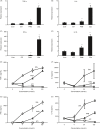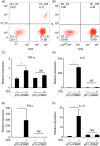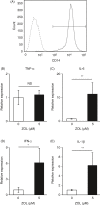Zoledronate promotes inflammatory cytokine expression in human CD14-positive monocytes among peripheral mononuclear cells in the presence of γδ T cells
- PMID: 33131052
- PMCID: PMC7884644
- DOI: 10.1111/imm.13283
Zoledronate promotes inflammatory cytokine expression in human CD14-positive monocytes among peripheral mononuclear cells in the presence of γδ T cells
Abstract
Bisphosphonates distributed to bone exert toxic effects specifically towards osteoclasts. On the other hand, intravenous administration of a nitrogen-containing bisphosphonate (N-BP) such as zoledronate induces acute-phase reactions (APRs), including influenza-like fever 1 day later, indicating an interaction with immunocompetent cells circulating blood. Although it has been reported that activation of γδ T cells is pivotal to induce an APR following treatment with zoledronate, downstream events, including the production of inflammatory cytokines after activation of γδ T cells, remain obscure. We investigated the effects of zoledronate on inflammatory cytokine expression in human peripheral blood mononuclear cells (PBMCs) in vitro. While zoledronate induced mRNA expressions of tumour necrosis factor-α (TNF-α), interleukin (IL)-1β, IL-6 and interferon-γ (IFN-γ) in PBMC, depletion of γδ T cells abolished that zoledronate-induced expression of those cytokines, indicating the necessity of γδ T cells for expression induction by zoledronate. However, which types of cells were responsible for the production of those cytokines in blood remained unclear. As it is generally accepted that monocytes and macrophages are primary sources of inflammatory cytokines, CD14+ cells from PBMC were exposed to zoledronate in the presence of PBMC, which resulted in induced expression of mRNAs for IL-1β, IL-6 and IFN-γ, but not for TNF-α. These results indicate that CD14+ cells are responsible, at least in part, for the production of IL-1β, IL-6 and IFN-γ in blood exposed to zoledronate. This suggests that CD14+ cells play an essential role in the occurrence of APRs following N-BP administration.
Keywords: acute-phase reaction; bisphosphonate; inflammatory cytokines; monocytes; zoledronate; γδ T cells.
© 2020 John Wiley & Sons Ltd.
Figures



References
-
- Delmas PD. Treatment of postmenopausal osteoporosis. Lancet. 2002;359:2018–26. - PubMed
-
- Neville‐Webbe HL, Holen I, Coleman RE. The anti‐tumour activity of bisphosphonates. Cancer Treat Rev. 2002;28:305–19. - PubMed
-
- Ralston SH, Langston AL, Reid IR. Pathogenesis and management of Paget's disease of bone. Lancet. 2008;372:155–63. - PubMed
-
- Rogers MJ, Gordon S, Benford HL, Coxon FP, Luckman SP, Mönkkönen J, et al. Cellular and molecular mechanisms of action of bisphosphonates. Cancer. 2000;88:2961–78. - PubMed
-
- Russell RGG, Watts NB, Ebetino FH, Rogers MJ. Mechanisms of action of bisphosphonates: similarities and differences and their potential influence on clinical efficacy. Osteoporos Int. 2008;19:733–59. - PubMed
Publication types
MeSH terms
Substances
LinkOut - more resources
Full Text Sources
Research Materials
Miscellaneous

